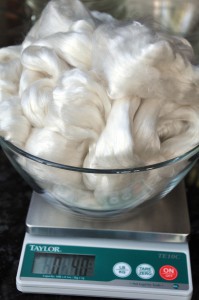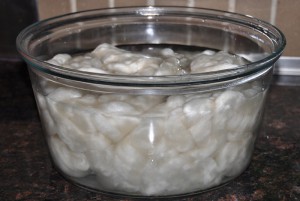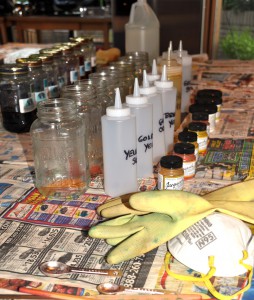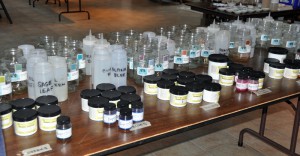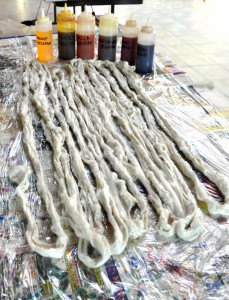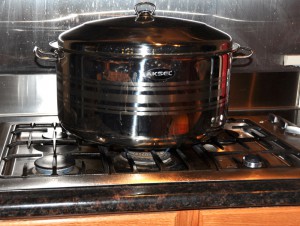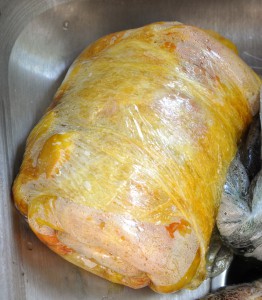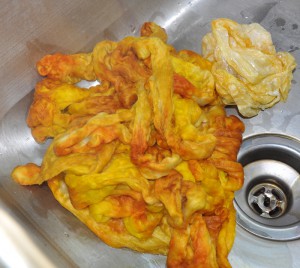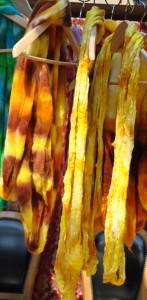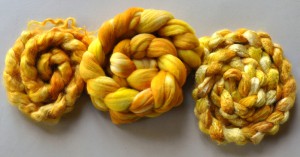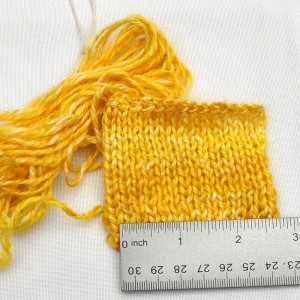Recently, I’ve had several people ask me about how I dye. Some just want to know for curiosity’s sake and others to learn how to do it themselves. These photos were taken about six months ago and posted on my Edgewood Garden Studio Facebook site to show a knitter’s customer how the wool for his daughter’s gift (a beautiful cowl) was processed. Here are the pictures again, with some more commentary so that you can learn more about the process.
The first thing that I do is weigh the wool roving. In this case, it is merino-silk which has a lovely sheen. I generally weigh 4 oz. pieces, as most spinning wheel bobbins will accommodate 2 ounces of wool, and I generally spin 2-py yarns in 4 ounce skeins.
Next I fill a container with lukewarm water. I carefully put the roving into the water, gently pushing it down. If I find I need to add water, I straddle one hand over the wool and pour the water on my hand rather than directly onto the existing water/wool. This prevents agitation which could felt the wool. The wool should soak approximately 20 minutes to half an hour at the minimum. Not to worry if you don’t get back to it in time, it can stay there for hours with no harm done. (There are stories of ships with bales of wool that were sunk for decades. When the wool was retrieved, it was still intact after the salt water was washed out.)
A bit about felting. Wool, looked at under a microscope, looks vaguely like a pine cone, with spiral scales with little hooks on the ends. These scales open out when they are wet and/or warm. If you agitate the wool at this point, the little hooks get impenetrably tangled and you have made felt. A wonderful property of wool, but not what we want to do during the dyeing process!
This is a picture of a very pristine work counter. In reality, it is generally MUCH messier. To be honest, this is staged for nice pictures. Do not rely on just newspaper to protect your workspace. I put overlapping layers of plastic wrap under the newspaper for some REAL protection. Since taking this picture, I have made a change in terms of gloves. The normal dishwashing gloves are a little “sticky” (to help hold soapy, slippery surfaces) and tend to “pull” on the surface of the wool. If you can get some nitrile gloves (sold in auto parts stores and some drug stores), they are the best for dyeing. Vinyl and latex gloves allow dyes to bleed through, so don’t rely on them to keep you from having colorful fingers! When dealing with powdered dyes, do wear a dust mask. The very fine dust is toxic.
I mix my dyes (Jacquard and Dharma Trading company ACID DYES) with boiling water in quart canning jars. It’s about 2/3rds hot water to dissolve the dyes and about 1/3 vinegar to provide the acidity required. Don’t overdo the vinegar, as too much makes the dyes fail to take on the wool. When the diluted dyes are cooled, we (my husband Mike is my ‘dye master’) transfer them to plastic squeeze bottles. Be sure to label your jars and bottles. One blue or green can look very much like any another blue or green when it’s just a dark liquid in a bottle.
When my dyes are mixed and in their squeeze bottles, I lay out a few overlapping sheets of plastic wrap on my work table. Then, I gently remove the wool from the soaking bowl by sliding my hands under the wool to lift up and out. Squeeze (do NOT wring) excess water out of the roving. I like to press it against the front side of a sink. Lay the roving out in zigzag on the plastic wrap. I generally lay them out in about two foot+ widths. By doing the zigzag, you ensure that there are reasonable repeats in your yarn and you don’t end up with a yarn that is one color at one end of the skein and another at the other.
Finally, it’s time to apply the dye to the wool. I use the squeeze bottle to run stripes about two inches in width, give or take, across the wool. Since I like the interaction of colors, I am not particularly concerned about segregating the colors, and so I allow for overlap. Since I spin worsted and finer, I do 2- to 3-inch color sections. If you want longer sections of color, adjust the width of the color on your roving. Remember, unlike dying YARN, these sections will be stretched out and the colors will blend a bit at the intersections in the spinning process as well.
Given that this example is all in one yellow-gold tone, it doesn’t show the wonderful interactions that the colors can have in a roving. Experimentation is the best teacher! I keep a couple of extra squeeze bottles for custom mixing of the liquid dyes “on the fly.” My full dye selection is about 45 different colors, but often, I have a hankering for something that does not come pre-mixed. That’s when “a little of this and a little of that” comes into play. Be sure you mix ENOUGH of your custom color as you will likely not get the exact same mix again.
Be generous with plastic wrap before you lay out the wool, as you will need to fold the sides over your dyed wool.
After I have folded over the sides of the plastic, I take the whole thing from the end and roll it up like a sleeping bag. This is what the “package” looks like when it is ready for steaming.
We use a gigantic stainless steel steam pot that I found on Ebay (made in Turkey), but you can use an enameled canning pot, too. Do not use a “reactive” pot and remember, NOTHING that is used in the dye process should EVER be used for food again. Inside the pot, we put a couple of inches of water, and the wool package rests in a large colander to keep it out of the water. Remember, the dyes are water soluble UNTIL they have been heat set! You want the hot steam to set the dyes, not dilute them in the boiling water! (Can you hear the voice of experience speaking here?) Be sure you have good ventilation. When weather permits and we can open all six doors in the studio and have both ceiling fans operating, we steam indoors. Otherwise (in the winter), we steam outside on a propane turkey fryer stand burner. The fumes are unpleasant. Be careful.
After 45-60 minutes, you can take out the steamed package. (Either dump it or use tongs—it’s HOT.) The plastic has become a little cocoon for the roving. Now, I KNOW that you want to see it immediately, but trust me, you want to LET IT COOL! Steam burns are really unpleasant (ask me how I know) and can put you out of commission for some time. I repeat, be patient: LET IT COOL.
When you open it up, the water that escapes should be nearly clear. I use four bins filled with lukewarm water (about the temperature of the wool at this point) and dunk the wool into each one successively, squeezing against the front of the sink in between each dunking. Do all this GENTLY. You don’t want to felt the wool at any point…and this is the easiest place to do it. When the water runs clear and the vinegar smell is gone, your yarn is ready for the last squeeze.
After squeezing against the sink, I fold the roving over two or three times and lay it on an old lengthwise-folded towel on the floor (Goodwill, Salvation Army and the like are good sources for old towels if you don’t have any on hand). Fold the towel again, lengthwise, so you have a long thin towel on the floor. Stomp on it. Don’t do the twist, just walk down the towel so that you have squeeze the wool thoroughly in its little towel encasement. Roll up the towel like a sleeping bag and let it sit for about 15 minutes. You will be surprised how much moisture comes out of the wool into the rolled towel in that time. Open the towel and hang the roving to dry. The colors will get lighter with the drying process.
For this particular yarn, I used three fibers: kid mohair, merino-silk, and 100% tussah silk….
….to produce a very soft yarn with a slight halo and subtle gradations of sunshine yellow.
I hope this helps you understand the process I use for dyeing roving (and sliver). Remember, this is just one technique and there are other ways to add beautiful colors to you wool. Experiment and try different methods and see what works best for you. If you have any questions, please don’t hesitate to contact me here, on Etsy (http://www.etsy.com/shop/EdgewoodGardenStudio?ref=si_shop), on Facebook (http://on.fb.me/s5rypX) or Ravelry (I’m GSD-Mom there.)

